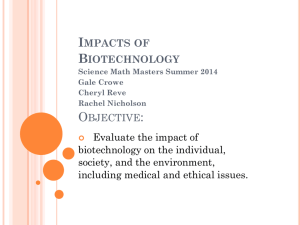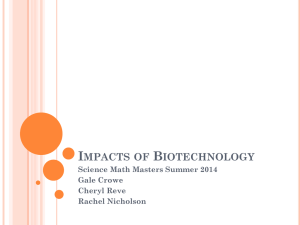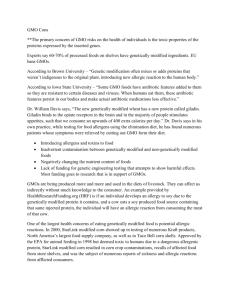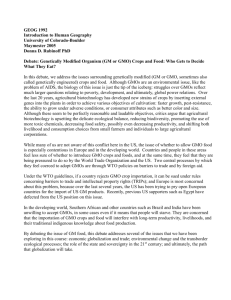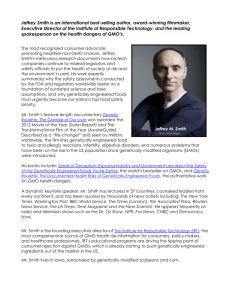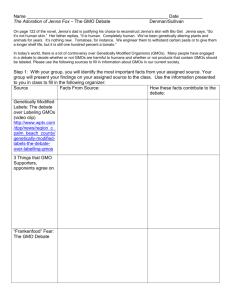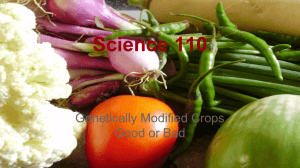Food Fight
advertisement
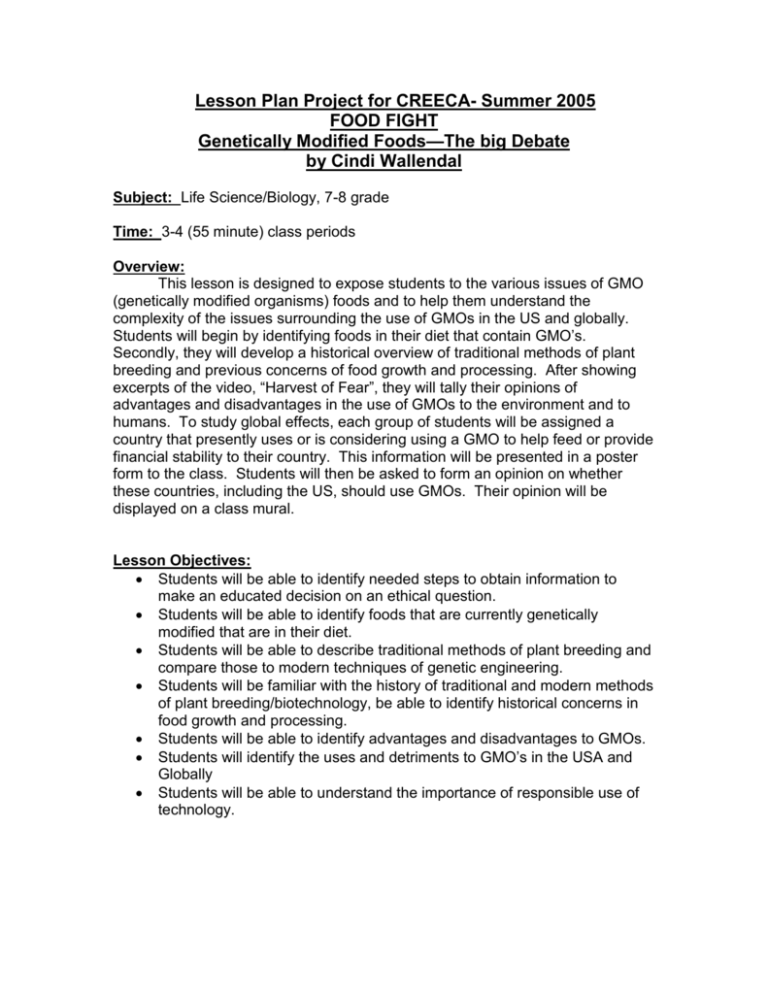
Lesson Plan Project for CREECA- Summer 2005 FOOD FIGHT Genetically Modified Foods—The big Debate by Cindi Wallendal Subject: Life Science/Biology, 7-8 grade Time: 3-4 (55 minute) class periods Overview: This lesson is designed to expose students to the various issues of GMO (genetically modified organisms) foods and to help them understand the complexity of the issues surrounding the use of GMOs in the US and globally. Students will begin by identifying foods in their diet that contain GMO’s. Secondly, they will develop a historical overview of traditional methods of plant breeding and previous concerns of food growth and processing. After showing excerpts of the video, “Harvest of Fear”, they will tally their opinions of advantages and disadvantages in the use of GMOs to the environment and to humans. To study global effects, each group of students will be assigned a country that presently uses or is considering using a GMO to help feed or provide financial stability to their country. This information will be presented in a poster form to the class. Students will then be asked to form an opinion on whether these countries, including the US, should use GMOs. Their opinion will be displayed on a class mural. Lesson Objectives: Students will be able to identify needed steps to obtain information to make an educated decision on an ethical question. Students will be able to identify foods that are currently genetically modified that are in their diet. Students will be able to describe traditional methods of plant breeding and compare those to modern techniques of genetic engineering. Students will be familiar with the history of traditional and modern methods of plant breeding/biotechnology, be able to identify historical concerns in food growth and processing. Students will be able to identify advantages and disadvantages to GMOs. Students will identify the uses and detriments to GMO’s in the USA and Globally Students will be able to understand the importance of responsible use of technology. Standards: Wisconsin Science standards that can be met with this lesson plan are the following: A. 8.1-Students will develop their understanding of the science themes by using the themes to frame questions about sciencerelated issues and problems. A.8.6- Students will use models and explanations to predict actions and events in the natural world. A.8.8- Students will use the themes of evolution, equilibrium and energy to predict future events of changes in the natural world. B.8.2-Students will identify and describe major changes that have occurred over time in conceptual models and explanations in the earth and space, life and environmental, and physical sciences and identify the people, cultures and conditions that led to these developments. B.8.6-Students will explain the ways in which scientific knowledge is useful and also limited when applied to social issues. C.8.9-Students will evaluate, explain, and defend the validity of questions, hypotheses and conclusions to their investigation. C8.11- Students will raise further questions which still need to be answered. F.8.10- Students will explain how some of the changes on the earth are contributing to changes in the balance of life and affecting the survival or population growth of certain species. H.8.1- Students will evaluate the scientific evidence used in various media to address a social issue, using criteria of accuracy, logic, bias, relevance of data, and credibility of sources. H.8.3- Students will understand the consequences of decisions affecting personal health and safety. Background Knowledge: To be successful with the following lessons students will need knowledge in the topics listed below. Mendel’s Laws Selective Breeding for specific traits Structure of DNA Processes or steps taken for genetic engineering Process of recombinant DNA Materials Needed: The video, “Harvest of Fear” Internet access Poster Board Specific types of food Large paper for mural Colored paper Introduction Activity: As a class make a list of what students know and understand about genetically modified foods/organisms. Lead the students into comments that suggest a change in genetic information, recombinant DNA, and suggestions as to why we have them. Ask the question, “ Why do you think genetically modifying organisms work? Answers should result in that living organisms share the same DNA code and synthesis of proteins and basic life functions. At the molecular level they are more alike than different. Genes are not unique to the organism, and humans are a good example where 99.9% of all human DNA is identical. Activity 1: Bring in food that is wrapped in its original container from the cafeteria or from home and display in front of the room. Add products that are organic to the items and ask the students if they think any of them are made with genetically modified organisms. If actual samples of the food cannot be found, use photos or labels that can be found on the websites, the True Food Network site. Suggest to them that 70% of our food is made with GMOs. Assign them to bring a list of foods that they find at home that are GMO products and food items that are not GMO produced. Tell them that they will need to provide proof of their examples. Provide them with the Internet site, www.truefoodnow.org/shoppersguide/guide_printable.html to use as a resource. Complete activity, “What are we eating?” found at www.pbs.org/teachersource/thismonth/june03. Discuss any comments or questions related to the quote, “Scientists are so preoccupied with whether or not they could, they don’t stop to think if they should.” Activity 2: What is the historical perspective of food production and how did we get to where we are today? Have the students create a timeline of the historical events that led up to GMOs. Include Mendel’s Laws, Rosalind Franklin, Watson, Crick, Cohen, Boyer, selective breeding, embryo technique, radiation and chemically caused mutations. Identify other concerns that have occurred to food processing such as microwaves, irradiation, food coloring, and pasteurization. Ask the question,” Is there concern with the use of GMOs?” Discuss the items that students brought to class and ask if they have concerns? Many should suggest that there was no labeling to tell them that the products contained GMOs, they didn’t know. Have this discussion lead into the next activity. See appendix A for timeline information. Activity 3: Using the internet site, www.pbs.org/wgbh/harvest, use the exercise titled, “Guess who’s coming to dinner?” and have students complete a chart that provides information on current GMO foods, their engineered traits, source of the new genes and its company name. Have students create a Venn diagram that compares and contrasts traditional methods to modern methods of seed production. Identify the major differences between traditional and modern techniques such as the amount of genetic material used, and the sources that the genetic material comes from. Conclusion to this exercise should reveal the number of products that are consumed by Americans without their knowledge, and general knowledge as to how the products were developed. See Appendix B for sample chart. Activity 4: Are GMOs safe to eat? Using the video, “Harvest of Fear”, show the excerpt titled as such to the students. Prior to showing the video have them make two columns on a paper that read, yes and no. Instruct them as they watch the video to place a check mark in the appropriate column as they sense an opinion during the video. Tell them that them should have numerous checks, as often there will be different opinions raised during the film. Have them record their yes and no tallies. Continue with the excerpt, “Are GMOs Good for the Environment”, and have students continue with their yes and no chart. Create a discussion listing the pros and cons heard on the video. Encourage the students to stay open minded until all information is collected. Activity 5: Do we need GMOs to feed the world? Show the portion of the video entitled as such. Have the students continue their tally. After the video section is complete, assign student groups a country that is presently using a GMO product. Have them research the use of the GMO and create a poster that illustrates the country and provides a minimum of 5 facts of the crop grown there. Use countries such as India, Argentina, China, Zambia, Canada, etc. Crops can be rice, cotton, sweet potatoes, coffee, rapeseed, papayas, and squash. Encourage students to include information that helps us decided if using GMOs are benefiting the country. Provide them with Internet sites to aid them in their search. Have them present their project orally to the class. Conclusion Activity: What is the Global Food Fight? Read orally or individually, the article “Hungering for Help: Genetically Modified Foods and the Developing World” from the Journal of Young Investigators. This can be found at www.jyi.org/volumes/volume6/issue2/features/williams.html. After reading the article discuss with them the following issues and questions: How serious is world hunger? Compare and contrast the conventional means of agriculture to technology based agriculture that is currently being practiced. What are the effects in using genetically modified seed to the native species in each country? Can the countries reduce hunger, malnutrition, and disease by using GMOs? Who will monitor responsible use of GMOs in these countries? Have them refer back to their tallies from the video in the yes and no columns. Ask them to come to a conclusion to the use of GMOs using all information that has been collected, and discussed. Ask them to put their conclusion in the form of a statement that supports their decision. Provide them with colored paper and ask them to write their statement on it and display all statements on a class mural. Assessment: Students completing all of the above activities can have their knowledge and understanding assessed in a variety of ways. Activities to assess: Ability to bring in food items Visits to assigned websites Creating and/or contributing to timeline Completion, “Guess Who’s Coming to Dinner” Tally sheets from video viewing Completion of assigned poster Oral presentation of poster Conclusion statement Discussions to assess: Why do GMOs work genetically? What is the responsibility of the scientist? What are the controversies in food growth and processing? Identifying the traditional and modern methods of seed production. Appendices A. Timeline Information: 1866—Mendel describes patterns of Heredity 1882—Cells have structures called chromosomes that determine traits. 1928---Morgan finds genes at specific locations on chromosomes 1900—Pasteurization of milk 1930—Invention of Electron Microscope 1944—Genetic material is made of DNA 1950—Use of chemicals and radiation to cause gene mutations in seed 1951—Rosalind Franklin images the structure of DNA 1962—Watson and Crick receive Nobel Prize for building a model of DNA 1965-- Use of microwave ovens to process foods 1970—Cohen and Boyer performed first gene transfer—artificial insulin 1990—First food is found in markets using biotechnology-cheese 1994—Super saver tomato is available to consumers 1995—Food is irradiated to destroy pathogens 2001—60-70% of all food is made with genetically engineered organisms B. Guess Who’s Coming to Dinner From pbs.org/teachersource Product Engineered Trait(s) Source of New Genes canola resists herbicide bacteria, virus chicory (radicchio) makes male sterile to facilitate hybridization bacteria corn expresses Bt toxin to control insect pests bacteria cotton resists herbicide tobacco, bacteria flax resists herbicide arabidopsis, bacteria papaya resist papaya ringspot virus bacteria, virus potato expresses Bt toxin to control insect pests bacteria, virus soybean alters oil to increase stability and reduces polyunsaturated fatty acids soybean, bean, bacteria, virus squash resists viruses bacteria, virus sugarbeet resists viruses bacteria, virus tomato alters ripening to enhance fresh market value bacteria, virus Sources: Agricultural Biotechnology and the Poor: Promethian Science G. J. Persley, www.cgiar.org/biotech/rep0100/morales Agriculture Biotechnology: Informing the Dialogue, College of Agriculture and Life Sciences, Cornell University, Cornell Experimental Station, Ithaea, NY “Harvest of Fear”, video from NOVA, Public Broadcasting Service, 2001 “Harvest of Fear”, online, Teacher Source and Classroom Activity site, www.pbs.org/wgbh/nova/teachers/activities Hungering for Help: Genetically Modified Foods and the Developing World, Shawna Williams, feature article in “ Journal of Young Investigators”, Issue 2, August 2002 Suggested Internet Sites: Video information and activities, “Harvest of Fear” www.pbs.org/wgbh/harvest Agriculture Biotechnology: Informing the Dialogue www.cornell.edu/agriculturelifesciences/biotechnology Wide Range of Teacher lessons and activities www.pbs.org/teachersource Hungering for Help: Genetically Modified Foods and the Developing World www.jyi.org Food and Agriculture Organization—Addressing Global Agriculture www.fao.org Agriculture Biotechnology and the Poor www.cgiar.org/biotech/rep0100 Online Newshour: Harvest of Fear www.pbs.org/newshour/extra Supporting Biotechnology in Agriculture www.agbioworld.org Union of Concerned Scientists--GMOs www.ucsusa.org Shoppers guide and list of GMO foods www.truefoodnow.org/shoppersguide
